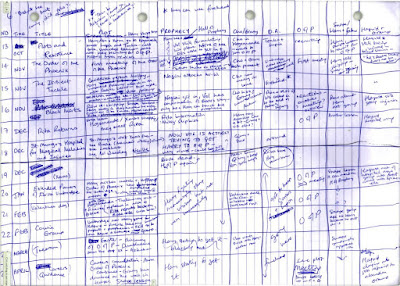 |
It's all in the story, says just about everyone. "Where (for authors) does success lie?" In the story, they say.
But what makes the story? And what makes a story good?
Plot is the first thing coming to mind for many. So, in this 2nd of 3 posts dedicated to Harry Potter (here's the 1st post), all in celebration of the recent 20th anniversary, I will discuss the next biggest element in what makes Harry Potter so dang good: simple ol' plot. (But it's never simple, is it?)
So here's a generic outline based upon my reading of this Harry Potter plot-points website, created by The Friendly Editor, which I found very informative and helpful.
- Curious events
- Empathy with the main character (or hero)
- Inciting incident(s)!
- And the 1st plot point, where the hero sets out on a journey, a.k.a. passes the point of no return
Then comes the middle of the book: Middle I
- Introduce antagonist(s) or, as I like to put it: antagonizing forces
- Hero is a fish out of water at this point, making mistakes, bumbling along (quite possibly is mistaking the main antagonist for another—think red-herring antagonist)
- Hero is experiencing a new world, trying to fit-in, suffering under peer-pressure
- All the while making new friends and new enemies
- Also, central mystery question is put: what central problem must the hero solve?
Now comes Midpoint!
A plot twist so gut-wrenching, changing, transforming that the hero switches from defense (Middle I) to offense (Middle II)- Hero takes initiative
- Starts to fight back (with help from friends)
- Searches for clues and finds them!
- Overcomes adversity, or his/her own fears, building to a final confrontation and climax
- But first...2nd plot point arrives, where the character is pinioned between antagonizing forces and must make a choice
- Where the hero learns something so irrefutable they must journey onwards to solve the central mystery, and that leads us to => the resolution
Resolution
- Final obstacle(s) and/or antagonist(s) are overcome
- No new characters are introduced (seems to be a golden rule of thumb here)
- Duplicity is revealed! Red-herrings exposed!
- Hero takes the lead, is the primary mover of events now
- (Also can revisit twist or 1st plot point here—for instance, what personal growth has the hero gone through? What do they need to revisit in order to solve the ultimate mystery?)
And, at last, the reader has earned it; the hero is, in fact, a hero; and we have: the Denouement
- Fuzzy Feel Good Time
- This is the point where the endorphins are flowing, a nice afterglow buzzing, and the we're left with a meaningful epithet, a bit of humor, and a classic close to action, where the audience stands and claps away and screams: "Encore! Encore!"
That's it, ladies and gents, my plot point scenario boiled down to a stinking finish stuck to the bottom of the pan. Based on the Friendly Editor's website. Hope I did it justice.
Now, how does Harry Potter come in? Well, it seems Rowling did a good bit of plot-diagraming in order to propel the story forward, make that book unputdownable, garner people's attention to the point where they were lining up around the block for the next issue in the series!
Here's a plot diagram I took from this website:
It's quite the dilly-loo of a diagram, and it's for the Order of the Phoenix, but here we see how Rowling mished and mashed plot-points and segments of plot together (Setup, Middles and Resolution) to form a quilt or tapestry, as you will.
So, what I'm saying is there's a method to the madness. The plots in Harry Potter have a lot to do with what reader's were expecting to read (since each book follows the same general outline of mystery-plotting shown above, i.e. the outline and tapestry), and when those readers were happily surprised by the new (but same) enfolding of events—of all of the separate plots and subplots of each book folding together into one grand plot of Harry facing and defeating Voldemort across the series—then those readers just kept clamoring for: "More! More!" and "Encore! Encore!" because they knew what to expect—plot-wise—book after book.
Think of it: Despite all of those books being written and published now, still fans are clamoring for: "More! More!"
Think of it: Despite all of those books being written and published now, still fans are clamoring for: "More! More!"
Because they got what they expected, and a sprinkling of a bit more (see my 1st post).
That's it. That's all. That's plot, for ya. It's brilliant. It's simple. But, it isn't simple, is it? ;)
Next, in my 3rd of 3 Harry Potter posts, I look at specific examples across the books in what gives us that fuzzy feel good feeling and why that is also crucial and unique to the success of the series.
